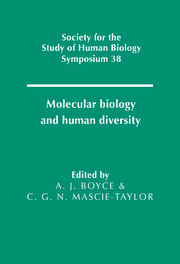Book contents
- Frontmatter
- Contents
- List of contributors
- Preface
- 1 Mitochondrial DNA in ancient and modern humans
- 2 Digital DNA typing of human paternal lineages
- 3 Minisatellites as tools for population genetic analysis
- 4 DNA fingerprinting: development of a technology and its application to the study of human populations
- 5 Kinship, inbreeding, and matching probabilities
- 6 Using the coalescent to interpret gene trees
- 7 Some attempts at measuring natural selection by malaria
- 8 AIDA: Geographical patterns of DNA diversity investigated by autocorrelation statistics
- 9 Mitochondrial DNA sequences in Europe: an insight into population history
- 10 Palaeolithic and neolithic contributions to the European mitochondrial gene pool
- 11 The molecular diversity of the Niokholo Mandenkalu from Eastern Senegal: an insight into West Africa genetic history
- 12 The peopling of Madagascar
- 13 Molecular perspectives on the colonisation of the Pacific
- 14 Population ancestry on Tristan da Cunha–the evidence of the individual
- 15 Linguistic divergence and genetic evolution: a molecular perspective from the New World
- 16 Allelic sequence diversity at the human β-globin locus
- 17 A nuclear perspective on human evolution
- 18 Contrasting gene trees and population trees of the evolution of modern humans
- 19 Methods and models for understanding human diversity
- Index
11 - The molecular diversity of the Niokholo Mandenkalu from Eastern Senegal: an insight into West Africa genetic history
Published online by Cambridge University Press: 19 September 2009
- Frontmatter
- Contents
- List of contributors
- Preface
- 1 Mitochondrial DNA in ancient and modern humans
- 2 Digital DNA typing of human paternal lineages
- 3 Minisatellites as tools for population genetic analysis
- 4 DNA fingerprinting: development of a technology and its application to the study of human populations
- 5 Kinship, inbreeding, and matching probabilities
- 6 Using the coalescent to interpret gene trees
- 7 Some attempts at measuring natural selection by malaria
- 8 AIDA: Geographical patterns of DNA diversity investigated by autocorrelation statistics
- 9 Mitochondrial DNA sequences in Europe: an insight into population history
- 10 Palaeolithic and neolithic contributions to the European mitochondrial gene pool
- 11 The molecular diversity of the Niokholo Mandenkalu from Eastern Senegal: an insight into West Africa genetic history
- 12 The peopling of Madagascar
- 13 Molecular perspectives on the colonisation of the Pacific
- 14 Population ancestry on Tristan da Cunha–the evidence of the individual
- 15 Linguistic divergence and genetic evolution: a molecular perspective from the New World
- 16 Allelic sequence diversity at the human β-globin locus
- 17 A nuclear perspective on human evolution
- 18 Contrasting gene trees and population trees of the evolution of modern humans
- 19 Methods and models for understanding human diversity
- Index
Summary
Introduction
The Senegalese Niokholo Mandenka population is located in the Niokholo Hills, 30 km North-West of Kedougou (Fig. 11.1). This population includes some 3000 individuals distributed in a dozen villages constituting an endogamous group with rare exchanges with two surrounding ethnic groups (Fulani and Bedik), and more commonly with other Mandenka populations living along the Gambia river and in the Saraya region (de Montal, 1985). The Niokholo Mandenkalu (Mandenkalu is the plural form of Mandenka) belong to the large Mande linguistic group, including several millions of speakers distributed between Mali and the Atlantic Ocean. The Mande is a subfamily of the large Niger–Congo family spreading from West Africa to Southern Africa. The Mandenkalu are thought to have settled in Eastern Senegal between the fourteenth and sixteenth century during the decline of the Mali Empire, coming from the East. A field trip in January and February 1990 allowed us to collect 203 blood samples in six villages a few kilometres distant from each other. Two hundred lymphoblastoid cell lines were successfully established, providing a continuous source of nuclear and mitochondrial DNA. The DNA polymorphism of several loci, such as α- and β-globin, HLA class I and class II, Y chromosome, mitochondrial DNA (mtDNA), and 80 random nuclear loci was then assessed in collaboration with several Swiss and international laboratories.
- Type
- Chapter
- Information
- Molecular Biology and Human Diversity , pp. 141 - 155Publisher: Cambridge University PressPrint publication year: 1996
- 4
- Cited by

